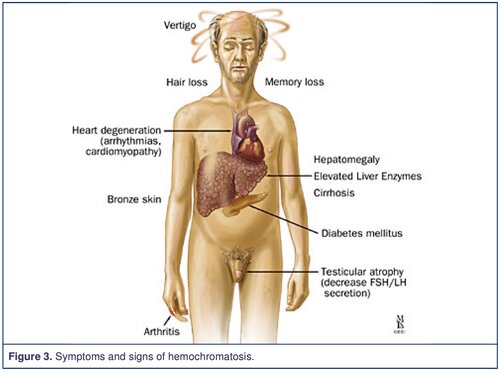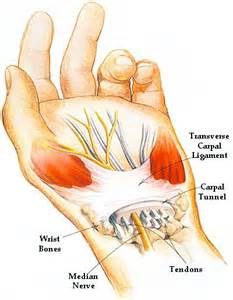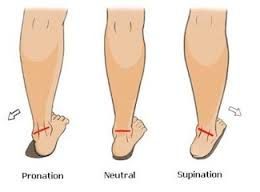Dead leg
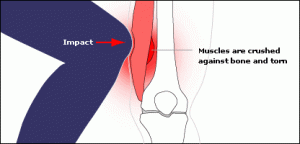 A ”dead leg”, also known as ”charley horse” or ”quadriceps contusion”, is essentially an injury due to a traumatic blow, crushing the quadriceps muscle against the femur bone. The quadriceps is the muscle at the front of your thigh. The injury can be either intermuscular or intramuscular. Treatment depends on the type of contusion and grade in severity of the injury. An Intramuscular contusion occurs when the muscle gets torn within the sheath surrounding it. This causes the initial bleeding to cease within hours due to increased pressure within the muscle. However, the fluid and blood is not able to escape from the muscle sheath surrounding it resulting in considerable loss of function and a lot of pain. This can take days or weeks for a full recovery. You are unlikely to see any bruising with this type of contusion, especially in the early stages. In the case of intermuscular contusions, the muscle as well as part of the sheath surrounding it gets torn. This results in a longer bleeding time initially, especially if there is no use of ice therapy. The patient usually recovers faster from this type of dead leg, as the blood and fluids can easily flow away from the injury site. Bruising is often present in this type of contusion.
A ”dead leg”, also known as ”charley horse” or ”quadriceps contusion”, is essentially an injury due to a traumatic blow, crushing the quadriceps muscle against the femur bone. The quadriceps is the muscle at the front of your thigh. The injury can be either intermuscular or intramuscular. Treatment depends on the type of contusion and grade in severity of the injury. An Intramuscular contusion occurs when the muscle gets torn within the sheath surrounding it. This causes the initial bleeding to cease within hours due to increased pressure within the muscle. However, the fluid and blood is not able to escape from the muscle sheath surrounding it resulting in considerable loss of function and a lot of pain. This can take days or weeks for a full recovery. You are unlikely to see any bruising with this type of contusion, especially in the early stages. In the case of intermuscular contusions, the muscle as well as part of the sheath surrounding it gets torn. This results in a longer bleeding time initially, especially if there is no use of ice therapy. The patient usually recovers faster from this type of dead leg, as the blood and fluids can easily flow away from the injury site. Bruising is often present in this type of contusion.
Grading
- Grade 1: Quadriceps pain, tightness in the thigh and a limp while walking. The swelling is very mild and so is the pain. The patient has almost complete range of motion upon stretching.
- Grade 2: The patient is not able to walk properly and limps when walking. There is some swelling present and the patient will experience bouts of pain upon activity. There is pain upon extending the leg against resistance. Pressure on the site also produces pain and the patient is unable to completely flex the knee.
- Grade 3:The patient has severe pain with obvious swelling, and is unable to walk without the help of crutches. Muscle contraction produces an obvious gap or bulge. This type of dead leg needs at least a month or two to completely heal.
Treatment
- I.C.E (Rest, Ice, Compression, Elevation).
- Rest is very important and the limb should be kept elevated as much as possible.
- Compression and ice therapy should be applied for 15 to 20 minutes every hour for the first 24 to 48 hours. Ice should be wrapped in a wet towel to prevent ice burns. A compression bandage should be worn 24/7 to reduce swelling and to give support until the pain has subsided.
- Crutches should be used if required.
- Never apply heat therapy(that includes having a hot bath…Do not) or perform deep tissue massage in the initial acute stage (24 to 48 hours) of a dead leg injury. This can aggravate the injury or lead to myositis ossificans later. Sports massage to help recovery should be started once the acute phase (24 to 48 hours) of the injury has passed, provided it’s not an intramuscular contusion(This may need more time to settle and sometimes requires medical intervention).
- Gentle stretching of the area should be done after the acute stage (24 to 48 hours) has passed, but not before, provided it does not cause too much pain. The stretch should be held for 30 seconds and should be repeated 4 to 5 times in a day. With severe (grade 3) intermuscular contusion there should be no overpressure with passive stretching for 7-10 days.
When Can Exercises Be Started?
- For dead leg of grade 1 contusion of quadriceps, strengthening exercises can be started as soon as the pain has subsided. Patient should start with mild exercises and should move on to difficult ones as the dead leg pain.
- For dead leg of grade 2 contusions of quadriceps, strengthening exercises should be started after a week or so. Patient should start with gentle warm up exercises and finish with good stretching exercises. Strengthening exercises should be continued for several weeks. Strengthening exercises should be started more than a week later and for grade 3 contusions of the quadriceps.
- Gentle exercises such as cycling or swimming are nice gentle strengthening exercises to start with.
Myositis Ossificans
The more severe a contusion, the greater the risk of development of Myositis Ossificans, especially with poor treatment and management. In this condition calcification occurs within the healing hematoma(swelling of clotted blood within the muscle). The healing hematoma forms bone within the layers of affected muscle. Symptoms include overnight and morning pain, as well as pain on muscle contraction. It may be possible to feel a hard bump or ‘woody’ lump within the affected muscle tissue. Stiffness and loss of knee range of movement are also common. Sometimes surgery is required to remove the calcified tissue.
Physiotherapists in Tralee
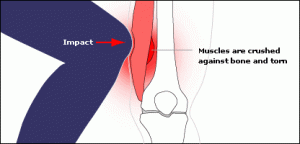
 A ”dead leg”, also known as ”charley horse” or ”quadriceps contusion”, is essentially an injury due to a traumatic blow, crushing the quadriceps muscle against the femur bone. The quadriceps is the muscle at the front of your thigh. The injury can be either intermuscular or intramuscular. Treatment depends on the type of contusion and grade in severity of the injury. An Intramuscular contusion occurs when the muscle gets torn within the sheath surrounding it. This causes the initial bleeding to cease within hours due to increased pressure within the muscle. However, the fluid and blood is not able to escape from the muscle sheath surrounding it resulting in considerable loss of function and a lot of pain. This can take days or weeks for a full recovery. You are unlikely to see any bruising with this type of contusion, especially in the early stages. In the case of intermuscular contusions, the muscle as well as part of the sheath surrounding it gets torn. This results in a longer bleeding time initially, especially if there is no use of ice therapy. The patient usually recovers faster from this type of dead leg, as the blood and fluids can easily flow away from the injury site. Bruising is often present in this type of contusion.
A ”dead leg”, also known as ”charley horse” or ”quadriceps contusion”, is essentially an injury due to a traumatic blow, crushing the quadriceps muscle against the femur bone. The quadriceps is the muscle at the front of your thigh. The injury can be either intermuscular or intramuscular. Treatment depends on the type of contusion and grade in severity of the injury. An Intramuscular contusion occurs when the muscle gets torn within the sheath surrounding it. This causes the initial bleeding to cease within hours due to increased pressure within the muscle. However, the fluid and blood is not able to escape from the muscle sheath surrounding it resulting in considerable loss of function and a lot of pain. This can take days or weeks for a full recovery. You are unlikely to see any bruising with this type of contusion, especially in the early stages. In the case of intermuscular contusions, the muscle as well as part of the sheath surrounding it gets torn. This results in a longer bleeding time initially, especially if there is no use of ice therapy. The patient usually recovers faster from this type of dead leg, as the blood and fluids can easily flow away from the injury site. Bruising is often present in this type of contusion.